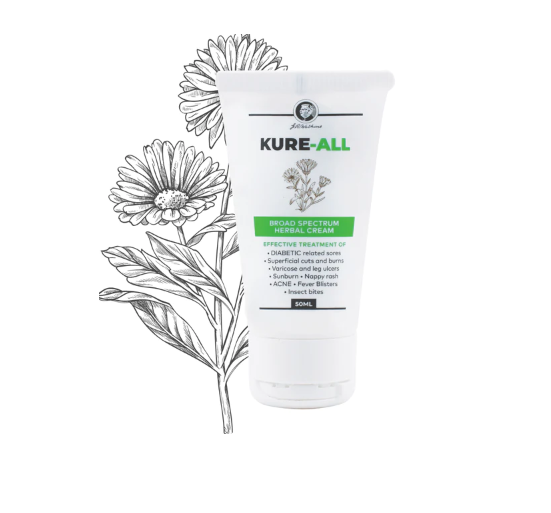KURE-ALL CREAM 50ML
KURE-ALL Cream & Spray are your first choice in the treatment of the following:
- Leg and foot ulcers.
- Acne.
- Cuts and abrasions.
- Nappy Rash.
- Fever blisters and cold sores.
- Burns and sunburn.
- Bites.

The Kure-All Broad Spectrum Herbal Cream is a multifunctional cream with a wide range of benefits. It repairs damaged and broken skin tissue, heals wounds and prevents infection.
Derma-Kure Cream and Fever Blisters/Cold Sores
Derma-Kure Cream alleviates pain and can stop cold sores in their tracks A cold sore typically progresses through four stages: first, tingling with gradual redness and swelling; second, formation of a blister as the virus replicates; third, ulceration as the wound weeps and fails to heal, often accompanied by infection; and finally, scabbing as a crust of blood and pus forms.
Unlike conventional medication, Derma-Kure Cream works at each stage. Used early, at the initial tingling stage, its ability to fight the herpes virus can stop the replication process - thereby preventing a blister developing. Its antibacterial action provided by the ingredient Calendula, can prevent secondary infection or fungal contamination, while its anti-inflammatory action has a local anaesthetic effect, relieving pain and discomfort. Derma-Kure Cream will also speed up healing of the damaged tissue (the ability to promote granulation and speed up formation of new skin cells) thus making the fever blister disappear more rapidly than other treatments available. Scarring and lesions are also greatly reduced.
DERMA-KURE CREAM IN BURN WOUNDS
The ingredients Calendula and Cantharis, are specifically indicated to relieve pain and to prevent infection in burn wounds. Derma-Kure Cream is an ideal debriding agent in burn wounds. The product keeps the wound moist while promoting granulation and epithelization to reduce the healing time and the trauma associated with burn wounds. Derma Kure pray can be sprayed on minor burns especially if there is pain associated with the burn.
How can diabetes affect the feet?
For people with diabetes, having too much glucose in their blood over an extended period of time can cause some serious complications, including foot and skin problems, as well as heart disease, stroke, kidney disease, eye damage, and other problems.
Diabetes can cause two problems that can affect your feet:
- Diabetic neuropathy — Uncontrolled diabetes can damage your nerves. If you have damaged nerves in your legs and feet, you might not feel heat, cold or pain. This lack of feeling is called diabetic neuropathy. If you do not feel a cut or sore on your foot because of neuropathy, the cut could get worse and become infected.
- Peripheral vascular disease — Diabetes also affects the flow of blood. Without good blood flow, it takes longer for a sore or cut to heal. Poor blood flow in the arms and legs is called peripheral vascular disease. Peripheral vascular disease is a circulation disorder that affects blood vessels away from the heart.
If you have an infection that will not heal because of poor blood flow, you are at risk for developing gangrene, which is the death of tissue due to a lack of blood. Each year a lot of people with diabetes have amputations. However, research suggests that more than half of the amputations can be prevented through proper foot care.
Derma-Kure Cream can promote circulation and heal minor cuts and sores that could lead to more serious complications. Used at night, Derma-Kure Cream when massaged into the feet and lower legs, will keep the skin hydrated and healthy thus preventing complications caused by diabetes.
How does diabetes affect the skin?
If blood glucose is high, the body loses fluid, causing the skin to become dry. This occurs because the body is turning the water into urine to remove excess glucose from the blood. The skin also can get dry if the nerves, especially those in the legs and feet, do not get the message to sweat (because of diabetic neuropathy). Sweating helps keep the skin soft and moist.
Dry skin can become red and sore and can crack and peel. Germs can enter through the cracks in the skin and cause an infection. In addition, dry skin usually is itchy, and scratching can lead to breaks in the skin and infection.
Skin problems are common in people with diabetes. Blood glucose provides an excellent breeding ground for bacteria and fungi and can reduce the body’s ability to heal itself. These factors put people with diabetes at greater risk for skin problems. In fact, as many as a third of people with diabetes will have a skin disorder related to their disease at some time in their lives. Fortunately, most skin conditions can be prevented and successfully treated if caught early. But if not cared for properly, a minor skin condition can turn into a serious problem with potentially severe consequences.
Now available in a Wound Spray
Ideal for cleaning both minor abrasions as well as deep cuts and ulcers.
